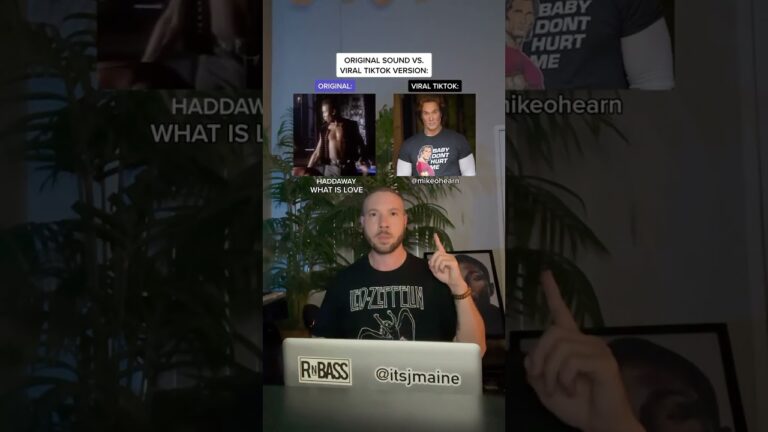[ad_1]
Original Song Vs. Viral Slowed Version: Haddaway “What Is Love” & Mike O’Hearn #shorts #music
This topic dissects the phenomenon of Haddaway’s 1993 Eurodance hit "What Is Love" experiencing a resurgence in popularity via a slowed-down version, frequently paired with content featuring bodybuilder Mike O’Hearn, particularly in the context of short-form video platforms like TikTok and YouTube Shorts. The analysis would involve exploring several aspects:
1. Haddaway’s "What Is Love" (Original Version):
-
Historical Context: Examination of the song’s origins, its release date (1993), and its place within the Eurodance movement. This includes understanding the musical climate of the early 1990s, characterized by the rise of electronic music and the proliferation of dance music genres.
-
Musical Structure & Production: A breakdown of the original song’s elements:
- Tempo: The original tempo (BPM – Beats Per Minute) would be specified.
- Key Signature: The key the song is written in.
- Instrumentation: Identification of the instruments used (synthesizers, drum machines, basslines, vocals, etc.) and how they contribute to the overall sound.
- Arrangement: Analysis of the song’s structure (verse, chorus, bridge, etc.) and how these sections build upon each other.
- Vocal Performance: Examination of Haddaway’s vocal style and its impact on the song’s appeal.
- Production Techniques: Exploration of any notable production techniques used in the original recording, such as reverb, compression, or equalization.
-
Initial Reception & Impact: A discussion of how the song was initially received by audiences and critics. This includes its chart performance in various countries (e.g., Billboard Hot 100, UK Singles Chart) and its cultural impact during its initial release.
- Music Video & Visuals: A description of the original music video and how it contributed to the song’s popularity. The video’s themes, imagery, and aesthetic would be examined.
2. The Slowed-Down Version:
-
Technical Transformation: Explanation of how the slowed-down version is created. This includes using digital audio workstations (DAWs) or audio editing software to reduce the playback speed of the original track. Mention of potential pitch correction or adjustments necessary to maintain the song’s key and avoid unwanted artifacts.
-
Musical Effect & Aesthetic: Analysis of the impact of slowing down the song on its overall feel and mood. The transformation often results in a more melancholic, dreamy, or dramatic sound compared to the original’s energetic dance vibe. The altered tempo changes the song’s groove and rhythmic feel.
- Viral Dissemination: Investigation into how and where the slowed-down version first gained traction. This might involve tracing its appearance on platforms like SoundCloud, YouTube, or TikTok.
3. Mike O’Hearn’s Role & the Meme Connection:
-
Mike O’Hearn’s Persona: A description of Mike O’Hearn as a bodybuilder, fitness model, and actor. This includes details about his physical appearance, fitness philosophy, and online presence.
-
Visual Association: Explanation of how Mike O’Hearn’s image became associated with the slowed-down version of "What Is Love." This often involves short video clips featuring O’Hearn’s stoic expressions, muscular physique, and slow-motion movements synced to the song’s rhythm.
-
Meme Culture & Humor: Analysis of the humorous and ironic aspects of the pairing. The juxtaposition of the intensely serious and physically imposing O’Hearn with the sentimental and slightly melancholic slowed-down song creates a comedic effect. The meme relies on the unexpected combination of elements.
- Spread on Social Media: Examination of how the meme featuring O’Hearn and the slowed-down song spread across platforms like TikTok, YouTube Shorts, Instagram Reels, and Twitter. Tracking the use of relevant hashtags (e.g., #WhatIsLove, #MikeOHearn, #SlowedAndReverb) and analyzing the engagement metrics (views, likes, shares, comments).
4. Cultural Impact & Broader Trends:
-
Revival of "What Is Love": Assessment of how the viral trend contributed to a renewed interest in the original "What Is Love" song. This could include increased streaming numbers, radio play, and remixes.
-
Use of Slowed & Reverbed Music: Discussion of the broader trend of slowing down and adding reverb to existing songs for use in short-form video content. This trend is driven by the desire to create a specific mood or atmosphere.
-
Copyright & Remix Culture: A brief exploration of potential copyright issues related to creating and distributing slowed-down versions of copyrighted songs. Discussion of fair use and the complexities of digital sampling and remixing.
-
The Power of Memes: Analysis of the power of internet memes to revitalize older songs and introduce them to new audiences. Memes can act as a form of cultural commentary and can shape the way we perceive music.
- Artist Response: Detailing whether Haddaway has responded to the renewed interest in his song due to the meme.
5. Conclusion:
-
Summarization of the key points and analysis of the phenomenon.
-
Reflection on the interplay between music, visual content, and internet culture.
- Discussion of the factors that contributed to the success of this particular viral trend.
[ad_2]

